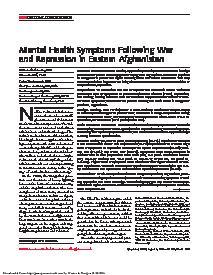Mental health symptoms following war and repression in eastern Afghanistan
Context Decades of armed conflict, suppression, and displacement resulted in a high prevalence of mental health symptoms throughout Afghanistan. Its Eastern province of Nangarhar is part of the region that originated the Taliban movement. This may have had a distinct impact on the living circumstances and mental health condition of the province's population.
Objectives To determine the rate of exposure to traumatic events; estimate prevalence rates of symptoms of posttraumatic stress disorder (PTSD), depression, and anxiety; identify resources used for emotional support and risk factors for mental health symptoms; and assess the present coverage of basic needs in Nangarhar province, Afghanistan.
Design, Setting, and Participants A cross-sectional multicluster sample survey of 1011 respondents aged 15 years or older, conducted in Nangarhar province during January and March 2003; 362 households were represented with a mean of 2.8 respondents per household (72% participation rate).
Main Outcome Measures Posttraumatic stress disorder symptoms and traumatic events using the Harvard Trauma Questionnaire; depression and general anxiety symptoms using the Hopkins Symptom Checklist; and resources for emotional support through a locally informed questionnaire.
Results During the past 10 years, 432 respondents (43.7%) experienced between 8 and 10 traumatic events; 141 respondents (14.1%) experienced 11 or more. High rates of symptoms of depression were reported by 391 respondents (38.5%); anxiety, 524 (51.8%); and PTSD, 207 (20.4%). Symptoms were more prevalent in women than in men (depression: odds ratio [OR], 7.3 [95% confidence interval {CI}, 5.4-9.8]; anxiety: OR, 12.8 [95% CI, 9.0-18.1]; PTSD: OR, 5.8 [95% CI, 3.8-8.9]). Higher rates of symptoms were associated with higher numbers of traumas experienced. The main resources for emotional support were religion and family. Medical care was reported to be insufficient by 228 respondents (22.6%).
Conclusions In this survey of inhabitants of Nangarhar province, Afghanistan, prevalence rates of having experienced multiple traumatic events and having symptoms of anxiety, depression, and PTSD were high. These findings suggest that mental health symptoms in this region should be addressed at the population and primary health care level.
Geachte bezoeker,
De informatie die u nu opvraagt, kan door psychotraumanet niet aan u worden getoond. Dit kan verschillende redenen hebben,
waarvan (bescherming van het) auteursrecht de meeste voorkomende is. Wanneer het mogelijk is om u door te verwijzen naar de bron
van deze informatie, dan ziet u hier onder een link naar die plek.
Als er geen link staat, kunt u contact opnemen met de bibliotheek,
die u verder op weg kan helpen.
Met vriendelijke groet,
Het psychotraumanet-team.
Reference:
Willem F. Scholte, Miranda Olff, Peter Ventevogel, Giel-Jan de Vries, Eveline Jansveld, Barbara Lopes Cardozo, & Carol A. Gotway Crawford | 2004
In: JAMA, the journal of the American Medical Association, ISSN 0098-7484 | 292 | 5 | 585-593
http://jama.jamanetwork.com/article.aspx
In: JAMA, the journal of the American Medical Association, ISSN 0098-7484 | 292 | 5 | 585-593
http://jama.jamanetwork.com/article.aspx
Keywords:
Abstracts, Mental Health Consequences of War


